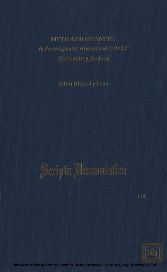Suchen und Finden
Chapter 1 STRUCTURALISM (p. 1)
Overview of Structuralism
The objective of this study is to provide a paradigmatic structuralist analysis of Galdós` Fortunata v Jacinta, published in 1887.1 This novel resists interpretation not only because it is made up of a richly-textured matrix of signs that has multiple symbolic levels, but also because its length adds to its complexity.
The paradigmatic structuralist method approaches understanding by affirming that the text is a meaningful totality or system of signs. For a text may be thought of as an autonomous semiological construct comprised of a system of signs distributed in definite ways, and having specific functions.
The meaning of the novel derives from the contrastive relationships of the constituent elements of signification. By selecting signs out of sequence for these contrasts and for the formation of models, this study is paradigmatic, it differs from the syntagmatic structural studies implemented by formalists and semiologists that are based on the string of the sentence.
Key ideas of Claude Lévi-Strauss1 anthropological structuralism serve as an interpretive resource for an understanding of this novel. Lévi-Strauss` notions about the languages of the cultures of real societies, such as the structures of kinship, totemism, mythology and other representations shaped by the mind, provide tools for interpreting the symbolic systems of the fictive society.
The two-phase procedure of the decomposition and subsequent paradigmatic reconstruction of models that reveal the underlying structures of surface phenomena, also are adopted from Lévi-Strauss and implemented in this study.
The analysis orders the signs into models that reflect the mechanisms of myths in the presentation of the data, and interprets findings within the context of the function of myths—which is to solve on mental levels irresoluble social paradoxes.
Also in keeping with Lévi-Strauss1 methodology, the findings are verified and validated by means of a comparison with the techno-économie infrastructure of the external society of nineteenth-century Madrid.
The rationale for this study grows out of a combination of six factors. Jean-Marie Benoist posits the notion of the polysemy or multiple meanings of texts, and refutes the idea of a single and true meaning. For texts are deemed to consist of "a bundle of relationships between various levels of meaning which can be described in structural terms."
Roland Barthes asserts that "a work carries several meanings by virtue of its structure, and that it is symbolic in the sense that it holds a plurality of meanings," which accounts for its everlasting quality. (Ibid., p. 13) Claude Lévi-Strauss stresses the importance of structure as an aid for discerning the meaning of cultural representations, by declaring that the structuralist method simplifies the plethora of surface phenomena by uncovering the deep structures that make them intelligible and understandable.
Structuralism is valuable because it provides an "epistemological model. . . that reveals behind phenomena a unity and a coherence that would not be brought out by a simple description of the facts. Structuralist facts are neither objective nor subjective, but are metaempirical.
Metaempirical facts form relationships that "are simpler and more intelligible" than the empirical surface structures, and structuralist thought "rediscovers and brings to the surface of the consciousness profound organic truths." (Ibid., p. 692)
Alle Preise verstehen sich inklusive der gesetzlichen MwSt.







